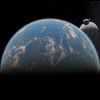|
How difficult would it be to implement procedural life?
|
|
| Rattus | Date: Sunday, 26.07.2015, 08:52 | Message # 16 |
 Observer
Group: Newbies
 Russian Federation
Russian Federation
Messages: 6
Status: Offline
| Quote FastFourierTransform (  ) but if some filters allow for a rapid search or some kind of evidence can be gathered while exploring to point out a system where there could probably be complex life, then it would be easier to find.
The only useful application for such "life search filter" as I see it - is to show the extreme rarity of life in Universe - and only in case of chances for abiogenesis for x*10^-24, where x - is a number of habitable worlds, that can be displayed in a one list of search issue.
And only in the purpose to dispirit user by awful biphobity of Universe.  But one should not forget that SE will be base for space-exploration game. It's obvious that life (especially complex life) - is the most precious find in universe. Such search filter will be just frustrating spoiler to the future players. But one should not forget that SE will be base for space-exploration game. It's obvious that life (especially complex life) - is the most precious find in universe. Such search filter will be just frustrating spoiler to the future players.
Besides, now astrobiological science can't determine even the order of life probability number in universe. Any exact value visible to user will be baseless in fact. SE can "lie" in individual details of generated worlds, but not in fundamental constants in the wide sense. At least - barefaced.  Life probability is belong to this constants too. Life probability is belong to this constants too.
Quote FastFourierTransform (  ) My opinion in all this issue is that we are embeded in classical geocentric and, many times, antropomorphic view of exobiology.  And this opinion is not rare from the time when Carl Sagan introduced term "Carbon chauvinism". And this opinion is not rare from the time when Carl Sagan introduced term "Carbon chauvinism".
And we want not to exclude alternative biochemistry architectures too.
But... Since Sagan introduced his term, structrural chemistry, systems biology, molecular biophysics and other sciences had set the new physical and structural limitations to starting conditions for life beginnings. Although now they are not exclude all variants of "exotic biochemistry".
Quote FastFourierTransform (  ) Why not life that dosen't need water, or not carbon based life-forms? How to predict their aspect with simple calculations?
Why not a life being that is only a pattern of chemical reactions over thousands of kilometers on a planet?
Why not life like this hypotesized by Tsytovich that could be dust grain and plasma based (and looks more probable than our own Earthly life-forms). Computer models showed that, when the dust became charged, the particles could self-organize into microscopic helical structures capable of replicating themselves, interacting with other neighboring structures, and evolving into more stable forms
Summary:
About architecture of life itself: Only way for life to set up and evolve complexiety with reasonable probability (i.e. not like Boltzmann Brain) - is Darwinian Evolution. In natural environment it can starts only on the base of digital encoded genetic apparatus. Athough Eugene V. Koonin in his book have not cleared the question about the necessity of digital encoding of biological information (as in Earth life) finally yet, a mathematician Sergey Vakulenko showed the strong evidence for this in his work (from page 33). Besides physicist Valentin F. Turchin in his book "The Phenomenon of Science"(1977) already have pointed importance of digital encoding in noisy environment (from page 18).
Briefly: Life must be based on a self-reproducing finite-state machine, able to Darwinian Evolution.
As for Conway's and other cellular atomata - they are much more models of pysical processes than biological ones. Because CA is about simple self-reproducing processes, but not about self-copying data arrays. Border between physics self-organisation and true life systems is here.
About physics base of life: Not any other known physical substances can provide complexiety and stability, enough to overcome Eigen threshold and create system, described above, except chemistry. Despite the self-organisation processes are rather widespread in Universe - only very few of them can lead to the rise of information-processing system.
Briefly: the True "von Neumann-Turing-Eigen-Darwin life machine" can arise naturally only by chemistry in our Universe.
About structural base of biomolecules: backbones of any biomolecules can't be built without carbon: Silicon can't form p-bonds that necessary as for [url=https://en.wikipedia.org/wiki/Stacking_(chemistry)]stacking interactions[/url], as for light assimilation. Boron is very rare in the Universe and we don't know mechanisms that allow it to concentrate in planetary amounts.
But: biomolecules can't be built on single carbon (hydrocarbons) too. If we take a look on backbones of our nitrogenous bases of nucleotides (RNA or DNA) (A) or peptides (proteins) (B), we will see at least one nitogen (blue) per two carbons (green). Nucleotides polymerise in RNA or DNA strands by phosphorus atom (magenta) at all. Therefore we can't exclude life with considerable amounts of other elements in backbones of their biomolecules.
Pure hydrocarbons are chemically passive and need high swings of temperature to synthesis/disintegration processes. Whereas known life looks like LEGO constructions than unit-cast structures. Heteroatoms in backbone of biomolecules are plays role of connections between LEGO-bricks: easy to assemble and disassemble in constant conditions.
Briefly: Pure carbon, silicon or even siloxane-based life is impossible, but organosiloxane-based life is not impossible yet.
About biosolvents: medium for any biochemistry must be based on liquid or supercritical polar solvent. It's obvious that complex structures can't exist in gas phase for a long time and could not actively interact with each others in solid state.
Non-polar (even little-polar) solvents (as small hydrocarbons on Titan) can't dissolve large molecules with heteroatomic groups - they are just fall in a sediment (like DNA in ethanol or tar and asphalt in oil refinery). Therefore non-polar systems exclude polar hydrogen bonds. This fact drastically decrease accessible complexiety to self-assembling structures in such media.
Briefly: there are three "with a half" natural liquid polar solvents - stable and sufficiently widespread - accessible for life: water, ammonia, supercritical carbon dioxide and (may be) sulfuric acid.
But nitrogen (as less electronegative element) in ammonia will lose the competition with oxygen for other elements - ammonia just can't dissolve oxides. And we don't know places in the Universe, where the nitrogen can accumulate in planetary amounts without oxygen.
But: Life in mixed water-ammonia pond is not impossible yet. Futhermore: water-ammonia eutectic solution can lower temperature limit of life down to -100°C. But biochemical reactions (and evolution) in such conditions will be considerably slower most likely.
(Earth life exists in liquid water between -18°C (in salt solution) and +122°C (under pessure of 2 atm).)
About other essential elements: Earth life involve one third of all common stable etements and many of them are essential. Include some metals (first of all: K+, Fe2+ or Mg2+).
Therefore planets, where a thick ocean layer have blocked metals from mineral crust by high-pressure ice, are lifeless.
Planets without tectonic activity are lifeless too (exept the cases of lithopanspermy from an other planet in system).
Briefly: planets with ocean deeper than ~100 km are lifeless.
Edited by Rattus - Wednesday, 17.08.2016, 14:21 |
| |
| |
| FastFourierTransform | Date: Sunday, 26.07.2015, 12:31 | Message # 17 |
 Pioneer
Group: Local Moderators
 Spain
Spain
Messages: 542
Status: Offline
| Quote Rattus (  ) We have a lot of discussions on this problems with "exobioenthusiasts"
Wow!! that's extremely interesting. Thank you for the detailled response 
I didn't knew about this restrictions at all. It's very interesting that the encoding can generally only arise by Chemistry.
But I want to ask you. What do you think about an alien creature that wouldn't fit in that model? like this one:
Simple Plasma-dust autoreplicating darwinian life-form compatible with frequently ocurring conditions in the Universe
Edited by FastFourierTransform - Sunday, 26.07.2015, 12:34 |
| |
| |
| Rattus | Date: Sunday, 26.07.2015, 14:59 | Message # 18 |
 Observer
Group: Newbies
 Russian Federation
Russian Federation
Messages: 6
Status: Offline
| Quote FastFourierTransform (  ) What do you think about an alien creature that wouldn't fit in that model? like this one
The main attribute of living system - is a self-copying "data array"(1D or 2D) - an irregular sequence of repeating symbols of sufficient length. That is the defining criterion. If the physicists will show a system that satisfies this principle - only then we can consider it living thing. In theese works I still not found nothing about a self-copying irregular sequences. Although I have not read them in detail.
Added (26.07.2015, 14:59)
---------------------------------------------
Concerning gaseous creatures: pure gas phase is inappropriate environment for life. But complex aerosol like mist or cloud - in presence of considerable amounts of mineral dust - still not forbidden too. Although I consider that solid-state mineral matrix is necessary for abiogenesis.
Edited by Rattus - Monday, 27.07.2015, 05:51 |
| |
| |
| Idgelios | Date: Monday, 27.07.2015, 15:23 | Message # 19 |
 Astronaut
Group: Users
 United States
United States
Messages: 77
Status: Offline
| Ice worlds and ocean worlds that are shallow enough still could have life, right? The mineral rich, warm from tidal locking rocky core of a ice world mixed with a water solvent seems like a place where life could arise due to chemical complexity. Water pressure may be a issue, but it's nothing life on earth hasn't found ways to deal with.
|
| |
| |
| Rattus | Date: Monday, 27.07.2015, 18:41 | Message # 20 |
 Observer
Group: Newbies
 Russian Federation
Russian Federation
Messages: 6
Status: Offline
| The addition problem is that Life needs not simple high chemical complexity, but specific and very high chemical complexity.
Now we know only one environment suitable for life beginnings on Earth: terrestrial anoxic geothermal fields.
Sodium-rich solutions are incapable of sustainig known pre-biotic processes.
Whereas potassium is less abundant than sodium about an order of magnitude. 
|
| |
| |
| Idgelios | Date: Wednesday, 29.07.2015, 00:14 | Message # 21 |
 Astronaut
Group: Users
 United States
United States
Messages: 77
Status: Offline
| Don't any hypothetical hydro-thermal vents in the depths of a ice world count as a anoxic geothermal field?
|
| |
| |
| Rattus | Date: Wednesday, 29.07.2015, 02:33 | Message # 22 |
 Observer
Group: Newbies
 Russian Federation
Russian Federation
Messages: 6
Status: Offline
| Quote Idgelios (  ) Don't any hypothetical hydro-thermal vents in the depths of a ice world count as a anoxic geothermal field?  And because we still know a very little about exoplanetogenesis and exogeochemistry - so this ignorance leaves us a window for legal speculations. And because we still know a very little about exoplanetogenesis and exogeochemistry - so this ignorance leaves us a window for legal speculations. 
But it have a simple meaning: life can not arise under a saline brine. Known halophilic (and all extremophilic generally) organisms - is a result of the quite long adaptive evolution - not an first universal ancestors.
Edited by Rattus - Wednesday, 29.07.2015, 03:00 |
| |
| |
| waterlubber | Date: Sunday, 06.12.2015, 22:42 | Message # 23 |
|
Observer
Group: Newbies
 United States
United States
Messages: 7
Status: Offline
| I would be satisfied with something like KSP's surface scatter. Maybe not "scientifically perfect" per se, but realistic-ish life. For example, unicellular life could be expressed as tinted areas of the ocean. Color really doesn't matter, for temperate organic life green or purple would work. For multicellular, plants would work well. A fractal based plant would be a good idea. This doesn't seem too hard to implement; but I'd like your opinions.
Generation would be:
1- Is life present?
2-Yes, organic multicelluar terrain
3-Generate a seed for fractals as well as a set of parameters
4-Use parameters to make similar plants
KSP Progress

Proud user of WINE and Linux, SE working perfectly
|
| |
| |
| SpaceEngineer | Date: Monday, 07.12.2015, 10:41 | Message # 24 |
 Author of Space Engine
Group: Administrators
 Russian Federation
Russian Federation
Messages: 4800
Status: Offline
| Quote waterlubber (  ) 4-Use parameters to make similar plants
This is the most hard part. Vegetation rendering is not easy, realistic generation of it is even more hard.

|
| |
| |
| 37ophiuchi | Date: Monday, 07.12.2015, 12:14 | Message # 25 |
|
Observer
Group: Users
 Pirate
Pirate
Messages: 16
Status: Offline
| Quote SpaceEngineer (  ) This is the most hard part. Vegetation rendering is not easy, realistic generation of it is even more hard.
Procedural life seems like such a waste of your precious development time...
There are so many much more feasible things that SpaceEngine would profit so much more from, e.g., "real", volumetric clouds and 3D-water.
|
| |
| |
| Spurdeau | Date: Saturday, 20.02.2016, 17:28 | Message # 26 |
|
Observer
Group: Newbies
 France
France
Messages: 5
Status: Offline
| It may not be a priority given Space Engine's positioning, resources and 2016 computational limitations ; but procedural life sure is a valuable and exciting feature !
If money was not object, I think developing such an add-on would be cool. This way, the main simulation wouldn't be cluttered and would be kept "scientifically pure" for those who prefer a very realistic simulation. For others like me who don't mind less scientifically rigorous features, procedural life would definitely be welcomed. Perhaps with could see it happen in the long term, if the MMORPG version of S.E. were to be funded (as announced in the donation goals).
|
| |
| |
| form_d_k | Date: Wednesday, 30.03.2016, 22:10 | Message # 27 |
 Astronaut
Group: Users
 United States
United States
Messages: 68
Status: Offline
| I assume it would be relatively simple to generate equivalents to algae, bacterial mats, mold, mildew, & descriptions for all sorts of microscopic life.  Here's hoping Space Engine can generate slime molds!! Here's hoping Space Engine can generate slime molds!! 
Edited by form_d_k - Wednesday, 30.03.2016, 22:27 |
| |
| |